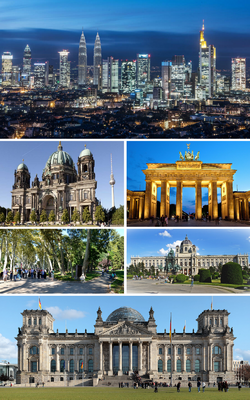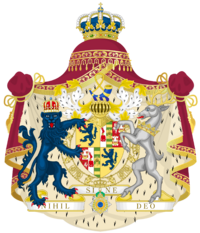Königsreh
Königsreh | |
|---|---|
| Free Imperial City of Königsreh Freie Reichsstadt Königsreh | |
 | |
| Nickname: "The Golden City" | |
| Motto: "Unser ist die Krone" ("Ours is the Crown") | |
| Country | |
| State | Kronlande |
| Government | |
| • Mayor | Paul Choldwig (RU) |
| Area | |
| • Capital city | 428.9 km2 (165.6 sq mi) |
| Elevation | 28 m (85.30 ft) |
| Population (2018) | |
| • Capital city | 3,231,326 |
| • Metro | 4,311,177 |
| Demonym(s) | Königsreher (m), Königsreherin (f) |
| Time zone | UTC+2 (EST) |
| Postal code | 01 |
| Area code | 536 |
| Vehicle registration | KR |
Königsreh (Hesurian: [ˈkøːnɪçsˌreh]; lit. King's Deer), is the capital and second largest city of Mascylla. It is populated by 3,231,326 (2017) inhabitants, which makes it one of the most populous city propers in Erdara after Krasno, Rakonitz and Flussmund. The city and its surrounding adjacent villages is one of Mascylla's 18 principalities, the Kronlande, and it is surrounded by the states of Eystrun, Folnery and Shwesia. Together it forms with Flussmund up north the largest metropolitan area in the country.
A global city and hub according to the Newcott World Cities Index, Königsreh is described as one of the world capitals of culture, finance, and media, and exerts a significant force upon commerce, entertainment, art, fashion, sports, technology and research, education, politics, and tourism. Home to the headquarters of the Assembly of Nations, Königsreh is an important center for international diplomacy.
The city lies on the banks of the River Blaugold, which flows through the city centre towards the Mask Sea. Königsreh's main topographical topographical features are the many smaller lagoons and lakes in the western and southern boroughs, all leading to the Blaugold, the largest of which is the Weider River. Due to its location in the Great Mascyllary Plain, Königsreh receives a temperate seasonal climate. Nearly one-third of the city's area is composed of forests, parks, rivers, canals, and lakes.
First mentioned in a road map of the 15th century and situated at the crossing of two important trade routes, the village in the past known as Schwülpt, became a minor political location and population centre. Its major importance was archieved through the foundation of the city of Königsreh by King Lukas I himself, after the construction of a national capital required a suitable location. Königsreh quickly evolved into a large metropolitan area, the fourth largest one in Erdara in the 1920s. The city served as the capital of the Mascyllary Kingdom (1793-1923), the May Republic (1923-1924), and the Crowned Republic of Mascylla until today.
Königsreh is an internationally recognized city of culture, politics, sciences, and general media. Its economy is based on high-tech start-ups and the service sector, encompassing a diverse set of innovative industries, research facilities, media corporations and scientific centres. Königsreh serves as a multinational hub for traffic, most notably through Königsreh–Albert Polschnitz Airport, and has a complex rapid transit network. The historical city centre is a popular tourist destination, with renowned universities, orchestras, museums, and galleries. Significant industries also include biochemical and biomedical engineering, IT tech, biotechnology, bionics, and aviation technology. Its zoological institutes, encompassed in the Zoologischer Park, is one of the most frequently visited zoos in Erdara. The city is well known for its multiculturalism, nightlife, contemporary lifestyle, and high social attractiveness; for example it hosts the famed Landherrenallee. It scores a high standard of living and has experienced a drastic rise in national, as well as international, popularity.


